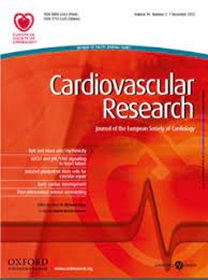EP4-纤维素-1的时空表达与血管内膜增生有关
IF 10.2
1区 医学
Q1 CARDIAC & CARDIOVASCULAR SYSTEMS
引用次数: 0
摘要
目的 环氧化酶-2 衍生的前列腺素 E2(PGE2)被认为会促进血管内膜增生(IH)。据报道,PGE2受体EP4在损伤血管中上调,血管平滑肌细胞(VSMC)中的EP4信号传导促进血管内膜增生。与此相反,内皮细胞中的 EP4 已被证实能抑制 IH。我们旨在研究 EP4 的时空表达以及调节 EP4 信号是否是一种可行的治疗策略。方法和结果 我们生成了 EP4 报告小鼠(Ptger4-IRES-nlsLacZ),并发现股动脉导线损伤 2 周后,增生的新内膜 VSMC 中有暂时但显著的 EP4 表达。与 SM22-Cre 小鼠相比,血管损伤 2 周和 4 周后以 VSMC 为靶点的 EP4 杂合缺陷小鼠(Ptger4fl/+;SM22-Cre)的损伤诱导 IH 减少,而与对照组(非 Tg)相比,以 VSMC 为靶点的 EP4 高表达小鼠(Ptger4-Tg)的损伤诱导 IH 加剧。我们随后研究了 EP4 在 VSMC 中的下游信号传导。EP4 的刺激增加了 Ptger4-Tg VSMC 糖蛋白纤维蛋白-1 的 mRNA 和蛋白水平。Fibulin-1C 重组蛋白通过转化生长因子(TGF)-β/Smad3 增加了 VSMC 的增殖和迁移,EP4 介导的增殖和迁移在 Fbln1fl/fl; SM22-Cre VSMC 和 CRISPR/Cas9 介导的 Fbln1 敲除 Ptger4-Tg VSMC 中减弱。我们生成了多个 fibulin-1C 基因缺失突变体,发现类 EGF 模块 6-8 似乎参与了 fibulin-1 介导的增殖。在纤维素-1的结合伙伴中,细胞外基质蛋白1(ECM1)也会因EP4刺激而上调,而且纤维素-1C和ECM1蛋白会增强VSMC的增殖和迁移。与 Fbln1fl/fl 相比,VSMC 靶向 fibulin-1 缺失小鼠(Fbln1fl/fl; SM22-Cre)的损伤诱导 IH 有所减轻。此外,全身给予 EP4 拮抗剂可减少野生型小鼠损伤诱导的 IH。结论 EP4 在增生性 IH 的血管内皮细胞中上调,EP4 信号至少部分通过纤维素-1 促进了 IH。可以考虑将 EP4 拮抗剂作为 IH 的治疗策略。本文章由计算机程序翻译,如有差异,请以英文原文为准。
Spatiotemporal EP4–fibulin-1 expression is associated with vascular intimal hyperplasia
Aims Cyclooxygenase-2–derived prostaglandin E2 (PGE2) is thought to promote vascular intimal hyperplasia (IH). It has been reported that the PGE2 receptor EP4 is upregulated in injured vessels, and that EP4 signaling in vascular smooth muscle cells (VSMCs) promotes IH. In contrast, EP4 in endothelial cells has been demonstrated to restrain IH. We aimed to investigate spatiotemporal expression of EP4 and whether modulating EP4 signaling could be a viable therapeutic strategy. Methods and Results We generated EP4 reporter mice (Ptger4-IRES-nlsLacZ) and found temporary but prominent EP4 expression in VSMCs of the proliferative neointima 2 weeks after femoral artery wire injury. Injury-induced IH was diminished in VSMC-targeted EP4 heterozygous deficient mice (Ptger4fl/+; SM22-Cre) 2 and 4 weeks after vascular injury compared to that in SM22-Cre, whereas injury-induced IH was exacerbated in VSMC-targeted EP4-overexpressing mice (Ptger4-Tg) compared to controls (non-Tg). We then investigated the downstream signaling of EP4 in VSMCs. Stimulation of EP4 increased mRNA and protein levels of the glycoprotein fibulin-1 in Ptger4-Tg VSMCs. Fibulin-1C recombinant proteins increased VSMC proliferation and migration through transforming growth factor (TGF)-β/Smad3, and EP4-mediated proliferation and migration were attenuated in Fbln1fl/fl; SM22-Cre VSMCs and in CRISPR/Cas9-mediated Fbln1 knockdown in Ptger4-Tg VSMCs. We generated multiple deletion mutants of fibulin-1C and found that EGF-like modules 6-8 appear to be involved in fibulin-1–mediated proliferation. Among binding partners of fibulin-1, extracellular matrix protein 1 (ECM1) was also upregulated by EP4 stimulation, and fibulin-1C and ECM1 proteins additively enhanced VSMC proliferation and migration. Injury-induced IH was attenuated in VSMC-targeted fibulin-1 deletion mice (Fbln1fl/fl; SM22-Cre) compared to Fbln1fl/fl. Furthermore, systemic EP4 antagonist administration reduced injury-induced IH in wild-type mice. Conclusions EP4 was upregulated in VSMCs of proliferative IH, and EP4 signaling promoted IH, at least in part through fibulin-1. An EP4 antagonist might be considered as a therapeutic strategy for IH.
求助全文
通过发布文献求助,成功后即可免费获取论文全文。
去求助
来源期刊

Cardiovascular Research
医学-心血管系统
CiteScore
21.50
自引率
3.70%
发文量
547
审稿时长
1 months
期刊介绍:
Cardiovascular Research
Journal Overview:
International journal of the European Society of Cardiology
Focuses on basic and translational research in cardiology and cardiovascular biology
Aims to enhance insight into cardiovascular disease mechanisms and innovation prospects
Submission Criteria:
Welcomes papers covering molecular, sub-cellular, cellular, organ, and organism levels
Accepts clinical proof-of-concept and translational studies
Manuscripts expected to provide significant contribution to cardiovascular biology and diseases
 求助内容:
求助内容: 应助结果提醒方式:
应助结果提醒方式:


